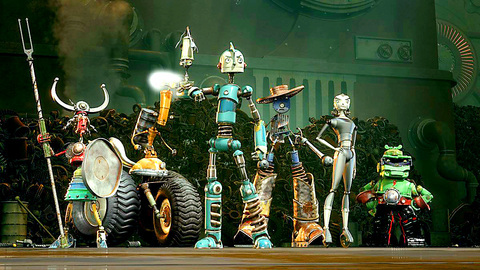Robots, directed by Chris Wedge and Carlos Saldanha, is a new 3-D computer-animated feature from 20th Century Fox's Blue Sky Studios, the outfit that brought us Ice Age, and like that movie it's a reminder that when it comes to innovative animated entertainment for all ages, there is Pixar, there is Japan and there is everybody else.
Not that Robots is bad, exactly. Visually it is fairly impressive, conjuring up a shiny, detailed world of ball bearings, gears, dents and rivets. Some of the jokes -- especially a bit at the beginning about the mysteries of robot reproduction -- are reasonably witty. The story, however, has been assembled by committee from the pop-culture junkyard: cool music on the soundtrack (including songs by Tom Waits and Fountains of Wayne); celebrity cameo voice-overs (Al Roker, to balance Katie Couric's moment in Shark Tale last fall); teary speeches about following your dreams -- and of course an annoying sidekick, voiced by Robin Williams, who played a similar role for Chris Rock at the Oscars last month.
Secondhandness is the method of Robots, and also its moral. The Bigweld company, once run by its kindly, roly-poly founder (voiced by Mel Brooks), has been taken over by Ratchet, a gleaming, soulless manager (Greg Kinnear) with a dastardly corporate mission. Encouraged by, for some reason, his clanky, fire-breathing mother, Ratchet wants to take replacement parts off the market and offer expensive "upgrades" instead. The broken-down "outmodes" who cannot afford to remake themselves will be swept off the street and sent to Ma Ratchet's underground furnace.

PHOTOS COURTESY OF FOX MOVIES
Of course, a plucky band of heroes unites to foil this plan, and the whole story can be read as an allegory of modern Hollywood, in which the imperative is apparently to overthrow the bad guys who want to make new stuff (and their mothers, too), so we can keep recycling the same old charming junk.
And to be fair, the look of Robots -- inspired by the boxy, streamlined look of mid-20th-century cars and kitchen appliances -- does have some charm. In the world of computer-generated imagery, metal has clearly replaced water as the great technical challenge. Now that Shark Tale and Finding Nemo have conquered wetness and scaliness, this movie and the forthcoming Cars from Pixar will set new standards for lifelike chrominess.
Robot City, a place inspired by Rube Goldberg, The Jetsons and Metropolis (both the Fritz Lang version and the recent Japanese anime), has impressive scale and variety, and there is a wonderful public-transportation set piece early on that thrillingly bends the laws of physics.

In the end, though, Robots is hollow and mechanical, an echo chamber of other movies and an awkward attempt to turn the intrinsically scary sensitive-robot theme into something heartwarming and cute. The hero, an aspiring inventor named Rodney Copperbottom (Ewan McGregor), is a pretty bland fellow, and for all Williams' vocal antic dialects and in-jokes, he does not breathe much new life into his stock character.
In addition to the annoying sidekick, there is a buzzing, chirping, flying coffeepot to fulfill the obligatory cute-pet role.
The film is being released both for standard movie screens and in the super-giant Imax format, and the latter version, come to think of it, was a little scary. There have been so many movies lately that warn us that machines are plotting to take over the world. Watching these clanky, smiling, big-eyed contraptions cavorting on an 80-foot screen, I could not help thinking that they had finally succeeded.


In the March 9 edition of the Taipei Times a piece by Ninon Godefroy ran with the headine “The quiet, gentle rhythm of Taiwan.” It started with the line “Taiwan is a small, humble place. There is no Eiffel Tower, no pyramids — no singular attraction that draws the world’s attention.” I laughed out loud at that. This was out of no disrespect for the author or the piece, which made some interesting analogies and good points about how both Din Tai Fung’s and Taiwan Semiconductor Manufacturing Co’s (TSMC, 台積電) meticulous attention to detail and quality are not quite up to

April 21 to April 27 Hsieh Er’s (謝娥) political fortunes were rising fast after she got out of jail and joined the Chinese Nationalist Party (KMT) in December 1945. Not only did she hold key positions in various committees, she was elected the only woman on the Taipei City Council and headed to Nanjing in 1946 as the sole Taiwanese female representative to the National Constituent Assembly. With the support of first lady Soong May-ling (宋美齡), she started the Taipei Women’s Association and Taiwan Provincial Women’s Association, where she

It is one of the more remarkable facts of Taiwan history that it was never occupied or claimed by any of the numerous kingdoms of southern China — Han or otherwise — that lay just across the water from it. None of their brilliant ministers ever discovered that Taiwan was a “core interest” of the state whose annexation was “inevitable.” As Paul Kua notes in an excellent monograph laying out how the Portuguese gave Taiwan the name “Formosa,” the first Europeans to express an interest in occupying Taiwan were the Spanish. Tonio Andrade in his seminal work, How Taiwan Became Chinese,

Mongolian influencer Anudari Daarya looks effortlessly glamorous and carefree in her social media posts — but the classically trained pianist’s road to acceptance as a transgender artist has been anything but easy. She is one of a growing number of Mongolian LGBTQ youth challenging stereotypes and fighting for acceptance through media representation in the socially conservative country. LGBTQ Mongolians often hide their identities from their employers and colleagues for fear of discrimination, with a survey by the non-profit LGBT Centre Mongolia showing that only 20 percent of people felt comfortable coming out at work. Daarya, 25, said she has faced discrimination since she